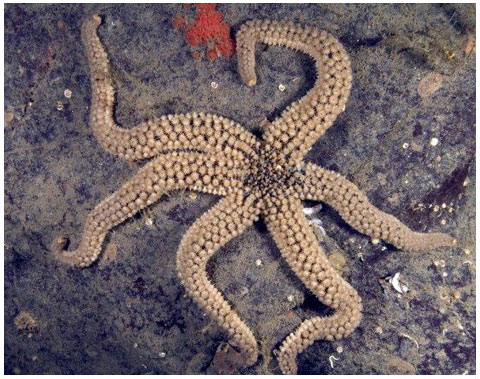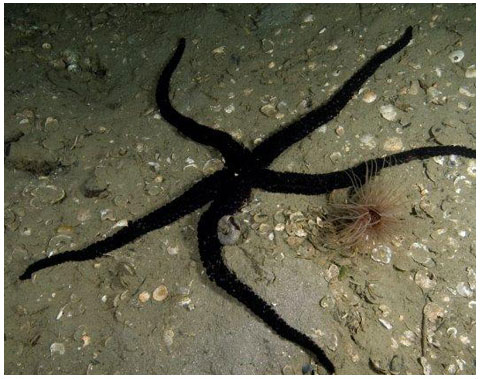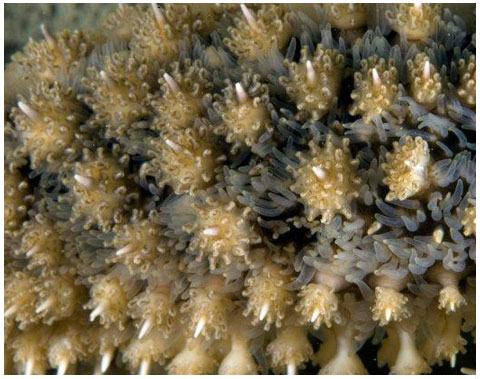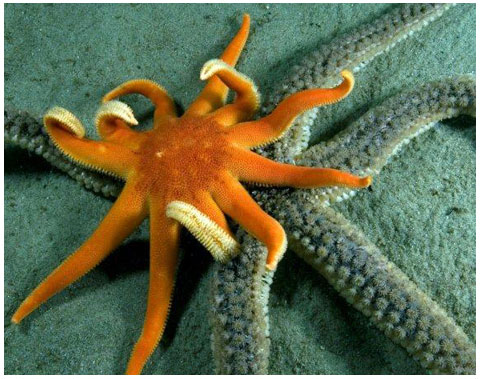
Class Asteroidea
Order Forcipulatida
Family Asteriidae
VELCRO STAR
Stylasterias forreri (deLoriol, 1887)
Identification:
5 very long tapering arms with small central disc. Rarely 6 rays. Many large spines surrounded by wreaths of tiny pincers. Grey, black, grey or more rarely, straw-coloured. Common name refers to the super-sticky surface. To 101 cm (40 in) across (a very large specimen found in Douglas Channel near Kitimat, BC).
Range:
Kodiak Island, Alaska, to southern California; 6 to 532 m (20 to 1,745 ft).







A typical VELCRO STAR. Note the grey colour, long tapering arms, small central disc and spiny surface.
A rare 6-rayed VELCRO STAR found in Howe Sound, BC. Oddly enough, a second 6-rayed specimen was found close by.
A black VELCRO STAR on a mud bottom. This specimen was very large, 81 cm (32 in) across.
Close-up view of the disc with the bright circular madreporite in the centre of the picture. Note that each spine is surrounded by a ring of tiny pincers. Tufts of thin-walled gills can also be seen.
An even closer view of the spines, showing the wreaths of crossed pedicellariae and tufts of gills.
A MORNING SUN STAR has attacked this VELCRO STAR but its powerful pincers are causing the predator much grief. The MORNING SUN STAR soon pulled its arms away and the VELCRO STAR escaped unscathed.
This one has captured a small sculpin and is beginning to eat it.
7 - 7
Previous
NEXT
Notes:
Prey include snails and chitons. I have found specimens eating small sculpins on a couple of occasions but it’s not clear how they caught the fish. It is rather uncommon, although it is seen more often toward the head of mainland fjords in BC, usually in deeper water. In general shape and ray length it looks somewhat like the RAINBOW STAR but the colour is very different.
This star is noteworthy for the wreaths of 35 to 40 crossed pedicellariae (mini-pincers) that surround the each of the surface spines. Shaped like tiny paired, many-barbed fish-hooks, these pincers are remarkably powerful. When stimulated, the circle of pincers rises up around each spine and the jaws open wide, ready to snap shut the instant they are touched. You'll quickly discover this if you brush against one with a neoprene-gloved hand. Instantly the star will be stuck like flypaper. When you try to remove it, it will stick like glue to your other hand! A large VELCRO STAR can have as many as 50,000 of these pedicellariae.
These wicked little pincers can capture small fishes and other prey that accidentally settle on the star's surface. The prey is transferred to the mouth by means of the tube-feet and rays. This star fights back aggressively when attacked by the MORNING SUN STAR, inflicting thousands of potent pinches with its arsenal of pedicellariae while fleeing. In lab tests it was clocked at a top speed of 32 cm/min.
INTRODUCTION | ABOUT SEA STARS | BIOLOGY | SPECIES | PREDATORS / PREY | SEA STAR WASTING DISEASE | ACKNOWLEDGEMENTS | FIELD GUIDE | VIDEO
Copyright © 2018 All rights reserved.